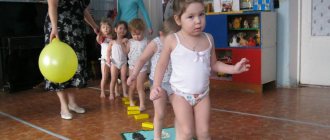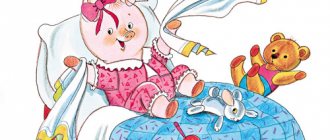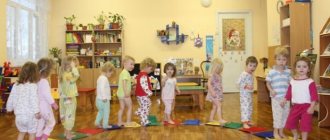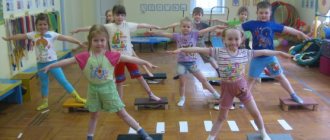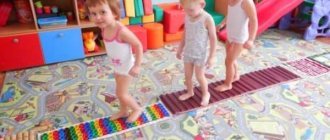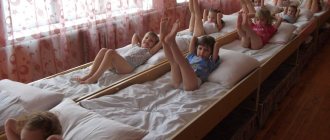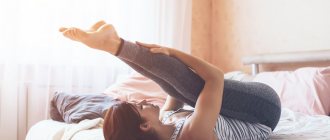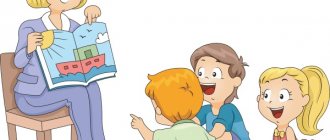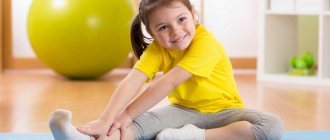Gymnastics after sleep in kindergarten: theory and practice
Natalya Vasylishin 08/31/2017 5 9.6k
Sleep plays a vital role in a child's daily routine. How the baby wakes up depends on his mood, state of health and how he will spend the rest of the day. In kindergarten, organizing a proper awakening is more difficult than for parents at home, because it is necessary for 15, 20, or even 30 people to throw off the shackles of Morpheus almost simultaneously, and to do it correctly. Solving such a problem is not easy, but with knowledge of some methodological nuances it is quite possible.
Goals, objectives and techniques
Gymnastics after sleep is a set of exercises that provide a smooth transition from calmness to wakefulness.
The objectives of such classes are:
- increase in muscle tone;
- improved mood;
- prevention of colds;
- strengthening the respiratory system;
- preventing the development of problems with posture, flat feet;
- fostering the habit of stretching the body after waking up.
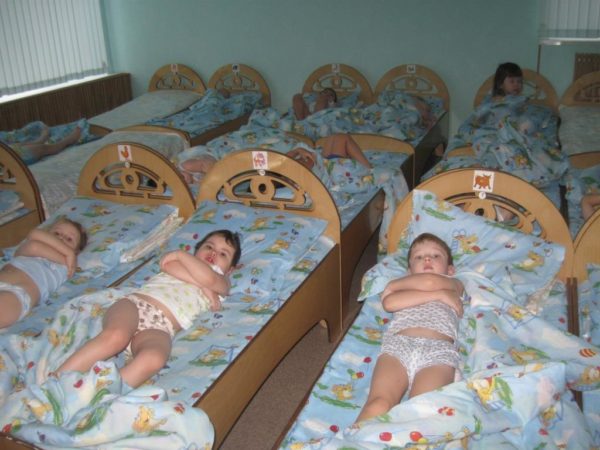
Not only his mood, but also the emotional atmosphere of the entire group depends on how each child wakes up.
To achieve the goals, every day the teacher selects exercises to solve problems such as:
- toning the nervous system (that is, preventing irritability and anxiety that may arise after waking up);
- improving the functioning of the body’s main systems (cardiovascular, respiratory, as well as stabilizing the body’s protective functions);
- creating a positive atmosphere in the group.
All this is possible with the right combination of gymnastics techniques after sleep.
- The plot of the awakening. This technique is especially important for children of the first and second junior groups. The essence of the technique is that all exercises are carried out within the framework of a common plot. For example, a bear came to visit us and asked for help: her son Mishka could not wake up, and he needed to go to help his mother to pick raspberries for the winter - he needed to show by example how to quickly restore the body after sleep. In addition, it will be more interesting for children to perform certain actions accompanied by rhymes and short sayings.
- Musicality. Quiet, relaxing music, played a little louder than before bed, helps children of any age recover.
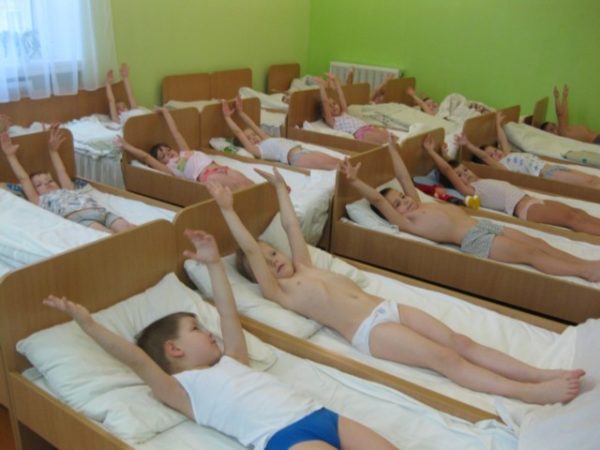
Gymnastics after waking up should be done to music
More information about gymnastics after sleep in the preparatory group can be found in our article - We conduct gymnastics after sleep in the preparatory group of the kindergarten.
Types of gymnastics, or a little about the terms
Gymnastics after sleep in some sources is called corrective, and sometimes includes corrective in its range of types.
This is interesting. Corrective gymnastics (from the Latin corrigo - straighten, correct) is a type of therapeutic gymnastics - special exercises to eliminate postural disorders; it also has a general strengthening effect (trains the functions of the cardiovascular and respiratory systems, strengthens individual muscle groups); restores balance between the curvatures of the spine.
Based on the definition, which includes the main goals and objectives of performing exercises after sleep, we can conclude that gymnastics after sleep, invigorating and corrective are all terms of the same synonymous series. Types of corrective exercises can be:
- correctional exercises (exercises aimed at correcting some specific disorders in the functioning of the child’s body, for example, flat feet or curvature of the chest);
- hardening (except for walking, hardening is not the lot of many people, because this is a special type of health procedures, which is carried out, as a rule, in specialized groups, it includes washing with cold water, dousing on the street, etc.);
- lazy gymnastics (exercises that are performed lying down, sitting, without sudden movements of strong physical exertion);
- physical education minutes (conducted regularly during breaks during classes, so that children not only take a break, but also work to strengthen the body);
- preventive gymnastics (a universal set of exercises that is most often used in preschool institutions).
This is interesting. Preventive gymnastics is sometimes called invigorating.
Types of exercises
If we talk about corrective gymnastics after sleep, it includes:
- exercises immediately after waking up - in bed;
- exercises using exercise equipment (for example, massage mats, balls, etc.);
- corrective tasks to prevent flat feet, spinal curvature, etc.;
- breathing exercises.
Rules for conducting invigorating gymnastics
To prepare children for the period of wakefulness in the afternoon, it is worth following a number of recommendations developed by the experience of teachers:
- The air temperature in the bedroom should not be lower than +16/+18 degrees.
- You need to choose a set of exercises taking into account the activities you had before going to bed. For example, before lunch the kids had a story game, which means that after sleep they can pay more attention to a block with squats, jogging, and body turns.
- For those little ones who wake up earlier, it would be a good idea to prepare 1-2 sets of exercises, for example, the “lazy” type.
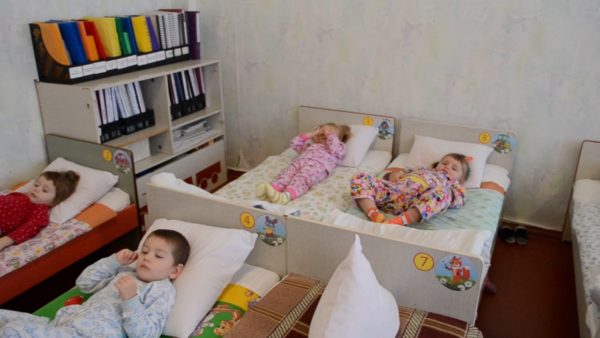
Children who wake up earlier should be occupied with exercises so that they do not wake up those who are still sleeping.
Methodology
If we summarize the above-mentioned features of the organization of corrective gymnastics, we can come to the conclusion that the optimal ratio would be a combination of 2-3 exercises in bed, 1-3 on the floor or on a rug and 2-3 breathing exercises performed to calm music (for example, sounds of nature or classics). In general, it will take 5–10 minutes to complete the gymnastics.
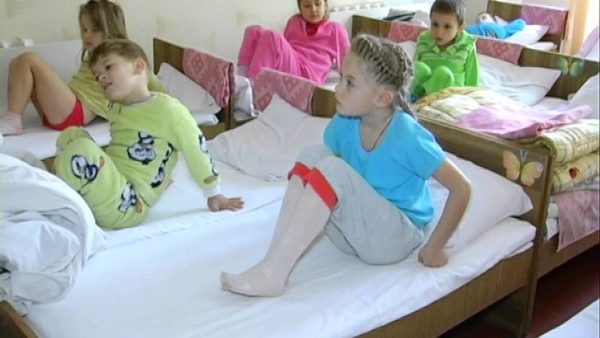
Spending 5-10 minutes after sleep helps maintain and improve children's health
Gymnastics complex for awakening from sleep for senior groups of preschool educational institutions

The day of children attending kindergarten is divided in half by naps. Waking up is a transitional moment that determines the child's mood for the rest of the day. Rest in the afternoon has a significant impact on the physical and intellectual development of children, helping them regain strength for new achievements. At the same time, it is very important to properly organize the awakening and cheer up the child. Daily exercises after sleep will help with this.
Exercises after sleep in kindergarten
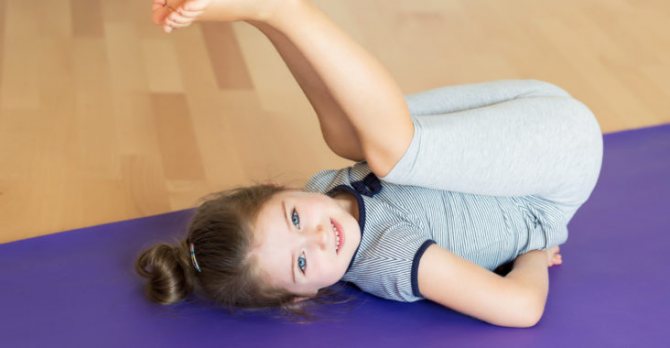
Kindergarten teachers are amazing people. How many tricks do you need to know in order to take care of and protect, feed and clothe, occupy and develop boys and girls all day long, and even so that they are friendly, cheerful, and healthy! Special sets of gymnastic exercises help each child maintain a healthy mind in a healthy body.
A preschooler's day is divided in half by naps, and waking up becomes a transitional moment on which the child's mood will depend for the rest of the day. That is why gymnastics after sleep is carried out in kindergarten every day. Short in duration, almost imperceptible for the children themselves, it smoothly and carefully helps them fill with vigor and strength.
Gymnastics after sleep in the senior group
Short-term gymnastics after a nap helps educators maintain a healthy mind in a healthy body and invigorate the child. She carefully and smoothly helps children wake up, fill themselves with strength and vigor.
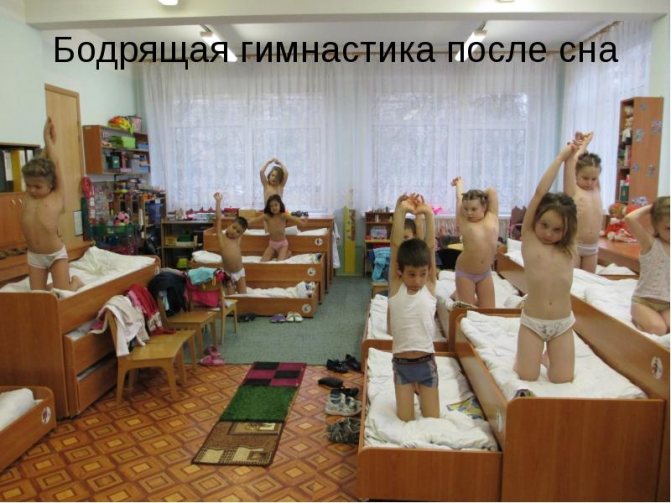
Invigorating gymnastics after sleep
What is it and what is it for?
Gymnastics after sleep in the older group is a set of exercises that helps children gradually move from a state of rest to wakefulness. On average, older preschoolers are given an average of 5 to 8 minutes to do exercises after waking up.
Gymnastics is necessary for the following:
- effective awakening;
- improving mood and emotional state;
- health promotion;
- prevention of colds;
- increasing muscle tone;
- preventing the development of disorders in the musculoskeletal system, scoliosis and flat feet;
- formation of healthy lifestyle habits.
Important! The teacher must closely monitor the performance of the exercises and explain to the students that they must be performed smoothly, without sudden movements. Otherwise, muscle strain and dizziness may occur.
The main purpose of exercises after a nap is to prevent irritability in preschoolers (if they still want to sleep), anxiety and the formation of a favorable emotional background in the group, as well as to improve and develop coordination of movements in children.
In order to achieve the desired results from a set of exercises, it is very important to carry them out correctly. It is recommended to draw up lesson notes taking into account those that preceded them. Immediately after waking up, the teacher should set the students up to do the exercises. When performing them, the room temperature should be maintained at 16 to 18 degrees. If some students wake up earlier than others, it is recommended to come up with additional activities for them that they can do. Children are not recommended to go barefoot during ARVI outbreaks.
Corrective gymnastics in preschool educational institutions
Corrective gymnastics in kindergarten.
Health is the natural state of the body, characterized by its balance with the environment and the absence of any painful changes. Human health is determined by a complex of biological (hereditary and acquired) and social factors; the latter are so important in maintaining a state of health or in the occurrence and development of disease that the preamble to the constitution of the World Health Organization states: “Health is a state of complete physical, mental and social well-being and not merely the absence of disease or infirmity.” (mental, physical, moral) One of the ways to solve this problem is to search and implement innovative approaches in physical education and health work. Corrective gymnastics are training sessions that provide specific effects on certain muscle groups in order to develop precise motor skills, breathing, provide nutrition and high-quality maturation of certain muscles. Purpose
recreational gymnastics is to teach children certain exercises for the prevention and correction of musculoskeletal disorders.
Objectives of corrective gymnastics:
Increasing the overall tone of the body, strengthening and creating muscle
corset to develop the skills of correct posture.
Prevention and correction of deformities of the musculoskeletal system.
Improving the functional ability of the external and internal system
breathing, cardiovascular and nervous system.
Increasing the mobility of the chest and diaphragm, strengthening the respiratory muscles.
General strengthening effect on children’s body and positive impact
on their psycho-emotional state, as well as the development of vital motor skills.
Development of strong-willed qualities that allow you to purposefully fight for recovery.
Systematically strengthening the skill of correct posture.
To special exercises for the prevention and correction of postural disorders
These include exercises aimed at strengthening the muscles of the anterior and posterior surfaces of the thigh, exercises for stretching the muscles of the anterior surface of the thigh and torso (with increased physiological curves), stretching the back muscles (with a decrease in physiological curves).
In addition to using natural factors of nature: air, water, sun - the following means are used in kindergarten: position correction, physical exercises, breathing exercises, with massagers, eye exercises, outdoor games, relaxation exercises. Corrective gymnastics is found in all routine moments in preschool educational institutions. In our kindergarten, all conditions have been created for a systematic, preventive influence on the growing child’s body. Throughout the day, the group maintains an optimal motor mode: morning exercises, walks, exercises after naps, physical education classes, physical education sessions, outdoor games, finger exercises, outdoor games, sports events, entertainment, swimming pool.
Methodology for conducting invigorating gymnastics in preschool educational institutions
In order for gymnastics after sleep in the older group to bring the expected results, it must combine several types of exercises. It is not recommended to include strength or endurance exercises in your post-sleep activities. The adequacy of the chosen load can be assessed by the children’s well-being after performing the exercises. If exercises invigorate, make children energetic and cheerful, then the load is optimally chosen.
Note! In the senior group of kindergarten, pupils can repeat previously learned exercises without a teacher, since at this age children have a very developed memory.

Methodology for conducting invigorating gymnastics in preschool educational institutions
Making a time plan
To maintain children's interest and emotional state, it is recommended to adhere to a time plan that regulates the implementation of each block.
After waking up, exercises are carried out in bed for 1.5-2.5 minutes. Then a transition is made to the active block, which involves performing gymnastics near the cribs. Its duration should vary from 2 to 3 minutes. After this, breathing exercises are performed for several minutes. The complex is completed by walking for one minute on massage mats.
Summary of awakening gymnastics in the senior group
When compiling notes, many teachers in the middle group of kindergarten prefer to use the book “Physical Culture of Penzulaev 4-5.” It describes in detail all the exercises that help preschoolers develop physically correctly, be cheerful and vigorous.
Note! When compiling notes, it is important to understand that the main goal of the classes is to form the habit of a healthy lifestyle and independent exercise at home.
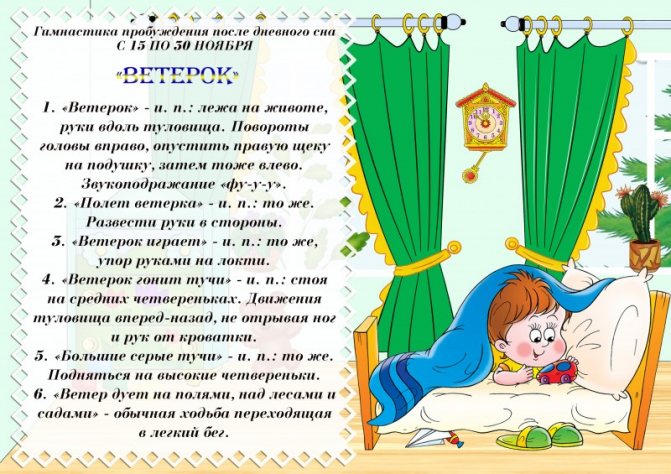
Exercise after sleep
Charging analysis
To get a general impression of the effectiveness of children's gymnastics after wake-up in the older group, it is necessary to regularly conduct analysis. The development of the analysis scheme is carried out by the methodological team of the kindergarten. Monitoring is carried out every month and determines how effectively certain techniques are used.
When conducting an analysis, an analytical report must be written, which indicates the name of the preschool educational institution, the name of the teacher, the age of the students and their number, and necessarily the date of the gymnastics. After this, the results of the activity are directly entered into.
Scheme of analysis of gymnastics after sleep
To understand whether conducting exercises after sleep in a particular kindergarten group is effective, you need to evaluate each of the stages of its implementation according to the scheme. First you need to specify:
- name of the preschool institution and group;
- teacher's name;
- date;
- age of children;
- number of children in the group.
Table: sample analysis scheme
| No. | Gymnastics stage | List and description of exercises | Time frame | Conclusion (goals achieved or not) | Notes |
| 1 | Start of the climb, toilet | 3 minutes | |||
| 2 | Exercises in bed | ||||
| 3 | Exercises on the mat | 4 minutes | |||
| 4 | Breathing exercises | 3 minutes | |||
Gymnastics after sleep is very important for children. After all, with its help, kids not only restore their tone, but also learn to take care of their health. And maintaining and restoring the child’s normal well-being is one of the main tasks of his stay in a preschool educational institution.
Complexes of health-improving gymnastics after sleep for children 5-6 years old
Health-improving gymnastics in the senior group has acquired particular relevance in recent years. This is explained primarily by the fact that the health of preschool children has steadily deteriorated. The set of exercises after sleep should include only gentle exercises and hardening elements.
Note! It should be performed only by those children who have no contraindications or restrictions to their implementation.
Gymnastics in bed
Before starting charging, the teacher must carefully prepare the room. He should open the curtains, open the window, especially in summer, spring and autumn, and play a quiet melody. For older children, the following exercises in bed are recommended:
- Stretching - children lie on their backs and lower their arms along the body. Then, one by one, they raise their arms up and stretch.
- Self-massage of the head - the teacher asks the children to sit on the bed and imitate washing their hair.
- We rest - the pupils lie on their stomachs with support on their elbows. The chin is supported by the palms. The teacher asks the children to alternately bend and straighten their knees.
Note! Exercises in bed help to gradually restore muscle tone after sleep and prepare them for active action.
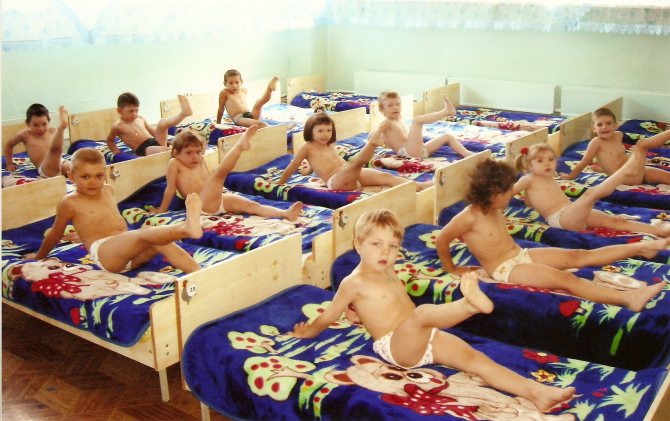
Gymnastics in bed
Prevention of flat feet
Special attention is paid to the prevention of flat feet in preschool institutions, since this disease has become very common among children. Children's age is more favorable for correcting the feet. After sleep, orthopedic massage mats are used in kindergartens for prevention purposes. Children walk on them barefoot immediately after their nap.
Prevention of postural disorders
Children should develop correct posture from an early age, so it is very important that children in preschool institutions perform special exercises aimed at preventing scoliosis. The main measures that will help prevent postural disorders are considered to be a set of exercises aimed at improving it.
Note! Preschool children are recommended to perform special exercises while standing near a vertical plane. Therefore, many educators prefer to do exercises with children after sleep near their cribs.
Breathing and sound gymnastics
A set of special exercises that are aimed at improving health and developing the child’s ability to relax is classified as breathing and sound gymnastics. The main goal of the teacher when performing such exercises is the desire to teach each child to breathe deeply and correctly, to be able to coordinate their own movements, to develop the speech apparatus and to cheer up after a nap.
Among other things, elementary exercises help to form the sound culture of speech and correct sound pronunciation disorders in childhood. The following exercises are considered the most common and effective:
Note! If a child has no speech problems at all, there is no point in giving up sound-breathing exercises in kindergarten, since the exercises will never hurt.

Master class (for MBDOU teachers)
“Methodology for conducting corrective and morning exercises in accordance with the Federal State Educational Standard for Educational Education and the individual characteristics of students”
Prepared by: physical education instructor at MBDOU “Rucheyok” Elena Yuryevna Babenko. Yamalo-Nenets Autonomous Okrug, Noyabrsk
Target:
• Familiarization of teachers with modern techniques and approaches to conducting morning exercises and corrective exercises in preschool educational institutions , aimed at preserving and strengthening the health of children, the successful formation and improvement of motor skills of preschoolers; developing the ability of teachers to organize and conduct morning and corrective gymnastics , which arouses children’s interest in physical education and sports, developing the habit of a conscious attitude towards their own health and a healthy lifestyle.
Tasks:
• Cover the tasks and importance of morning exercises for preschoolers
• Determine the content of morning exercises in accordance with the age needs and capabilities of preschoolers.
• Present the methodology for conducting morning exercises with teachers in the form of a master class .
Relevance : In light of the state's priority task of preserving the health of the population, the main direction of work of teachers in preschool educational institutions is to preserve and strengthen the health of preschool children.
Morning exercises are included in a number of physical education and health activities of preschool educational institutions aimed at the full physical development and strengthening of children’s health.
Fascinating, selected in accordance with the age needs and capabilities of preschool children, morning exercises contribute to the development of children's interest in physical education and sports, instilling in children a sense of purpose, organization, initiative, a desire to perform physical exercises daily, and forms the foundations of a healthy lifestyle.
Morning exercises are a set of specially selected exercises that are carried out with the aim of adjusting , “charging”
the child’s body for the entire coming day.
Morning exercises are carried out in the hall , in a group room, on the site in spring, summer, and autumn.
General developmental exercises should be selected so that all large muscle groups are included in the work one by one. The exercises that are included in the complex should be familiar to children: the exercises are first learned in physical education class and only then taken to morning exercises . Each complex lasts two weeks . In younger groups, more game techniques are used; children perform all exercises together with the teacher . In older groups, the teacher tries to give a clear explanation instead of showing the exercise himself or the child showing the exercise. The morning exercise complex consists of three parts: introductory, main and final. As a rule, the introductory part includes various types of walking and running (sometimes simple game tasks)
.
This is a little warm-up. The main part is general developmental exercises with objects (flags, handkerchiefs, skittles, cubes, hoops, balls, etc.)
These exercises contribute to the health of the body, develop muscle strength, joint mobility, form correct posture and the ability to navigate in space.
When performing gymnastic exercises, it is necessary to observe and alternate starting positions (standing, sitting, lying on the back and stomach, since a static posture negatively affects the posture in general and the formation of the arch of the child’s foot. In the final part of , walking at a moderate pace and games
are performed low mobility to restore breathing, elements of health-saving technologies are included that promote full physical development: • Exercises to restore breathing
• Finger gymnastics ,
• Exercises for the eyes,
• Exercises to prevent flat feet, self-massage and others.
Exercising after a nap. Corrective gymnastics is a type of therapeutic gymnastics and consists of general and special parts. The general part is general strengthening exercises, which are components of the activity of a child with visual impairment; they contribute to the correct formation of the musculoskeletal system. Special correction (active
corrective exercises ) involves solving the main problems:
- strengthening the muscle corset, mainly the back muscles;
— prevention and treatment of functional insufficiency of the feet;
— strengthening the abdominal muscles;
— prevention of secondary deviations.
corrective gymnastics exercise is performed 6 times.
Method of performing gymnastics after a nap.
The main goal of gymnastics after a nap is to lift the mood and muscle tone of children with the help of contrasting air baths and physical exercises.
General tasks of gymnastics:
• To develop in children vital motor skills and abilities that help maintain correct posture, feet and correct spinal curvatures.
• Promote harmonious, proportional development of the body, the formation of beautiful posture, grace.
• Develop the child’s motor abilities, plasticity, endurance, awareness while maintaining correct posture.
gymnastics complex consists of several parts:
1. Gymnastics in bed
2. Exercises to prevent poor posture and flat feet
3. Breathing exercises
4. Individual tasks
5. Water treatments
While the children are sleeping, the teacher prepares “cold”
room (playing room, where the temperature with the help of
ventilation is initially reduced by 3-5 degrees, compared to a “warm”
room. Awakening occurs to the sounds of smooth music with a gradual increase in volume.
Gymnastics in bed is aimed at gradually transitioning children from sleep to wakefulness. The teacher starts it with the children who have already woken up, the rest join as they wake up. Gymnastics in bed includes stretching, alternately raising arms and legs, and a set of exercises starting from head to toe . The main rule is to avoid sudden movements that can cause muscle strain, overexcitation and, as a result, dizziness. The duration of gymnastics in bed is about 2-3 minutes.
Then the children go into the “cold”
room.
In the "cold"
In the room, children perform
corrective gymnastics : walking on their toes, on their heels, with high knees, in a half squat on the outside of the foot, with a heel-to-toe roll, walking along corrective paths . It is important to monitor not only the correct execution of the exercises, but also the posture of children. Then the children perform exercises to prevent postural disorders. To interest children, you can use cubes, gymnastic sticks , balls, rattles, etc. The duration of this part is 2-3 minutes.
Then breathing exercises . Breathing exercises are important for restoring heart rhythm, relieving anxiety, strengthening the immune system, and preventing upper respiratory tract diseases.
Performing the breathing exercise “ Steam Locomotive”
: arms bent at the elbows, walk around the playroom making alternating movements with your arms and saying: CHUH-CHUH-CHUH. Their dosage should be increased gradually from 30 seconds to 2-3 minutes.
Practical part (conducting morning exercises): And now, dear teachers, we will be in the role of children in the preparatory group for school. And we will perform a set of morning exercises with gymnastic sticks.
Equipment: visual cues, gymnastic sticks with marks, individual mats, musical accompaniment.
1. Introductory part. Line up according to height. Executing commands.
Instructor: Every day for us, guys, begins... Teachers: With exercises!
Instructor: And of course, it is very important that you do exercises... Teachers: Everyone!
Formation into a column of two, turning while moving, and in two ranks (opposite)
turning on the spot.
A set of general developmental exercises with gymnastic sticks “We are athletes” (school preparatory group).
Part I. _ Introductory. Walking and running in a column one at a time, with acceleration, walking on toes, walking on heels, walking and running with acceleration. At the teacher’s signal, take the sticks. Rearrange into 2 columns with twos entering.
From the site administrator: if you want to read the full text of the presented publication, you can download it from the site in full.
Downloaded: 136 times
Card file of awakening gymnastics for the senior group with goals according to the Federal State Educational Standard
According to the Federal State Educational Standard, a set of exercises for the older group after waking up should be performed every day at the same time. Exercise helps you wake up and adds energy. As a result, the child’s general well-being improves, and he feels great for the rest of the time. In addition, exercise helps to form the habit of leading a healthy lifestyle and systematically performing exercises.
A set of activities after sleep has a beneficial effect on the process of developing a child’s personality. Thanks to it, if all recommendations are followed, preschoolers increase physical endurance, concentration, develop communication skills with people, and also instill a love for a healthy lifestyle and sports.
Vitality and well-being are directly affected by a child’s daily routine. Full and normal sleep is very important for children’s health, which is a routine moment in kindergarten.
Note! Effective and properly selected gymnastics is an important condition. Therefore, educators are developing a special set of exercises that are aimed at quickly waking up, activating all muscle groups, creating optimal conditions for continuing the day, as well as increasing well-being and improving mood.
In the senior group of kindergarten, the lesson time may be increased compared to the middle and junior ones. It is also recommended to include classes with sports equipment and exercise equipment in the complex. The kids really like this idea, because at this age they are active and mobile. As practice shows, the more exercises a teacher offers children to do, the more delighted they are.
Exercises can also be combined with mental games and special exercises for mental development. In this case, the children remain happy and feel great for the rest of the day.
Gymnastics for waking up from sleep for the older group is an integral part of the day in kindergarten. Relaxing in the afternoon will help children regain strength for new achievements. However, it is important to adhere to certain awakening rules, using special techniques.

Editor: Elizaveta Sergeevna Koneva
Primary school teacher of the first qualification category, defectologist.
Elements of gymnastics after sleep
Gymnastics after sleep is like a multi-colored mosaic that can be reassembled every day, creating a new image from its main elements. Daytime gymnastics, as an option, may include:
- stretching;
- breathing exercises;
- swing your arms;
- stroking biologically active zones;
- jumping;
- squats;
- simple elements of yoga;
- finger gymnastics;
- gymnastics for the eyes;
- visual-acoustic exercises.
Despite the fact that gymnastics after sleep is usually short-lived, the teacher can combine individual elements and use the developments he likes in fragments.
Video example of morning exercises:
Daytime sleep is longest in the younger group of kindergarten. It can be difficult for kids to wake up in a good mood. If they were in a deep sleep, they may not immediately realize where they are. Children cry, are capricious, refuse to get up, wash, or get dressed. Therefore, during the exercises, the emphasis is on the emotional component of gymnastics: the correct selection of music, speech accompaniment, harmonization of the general atmosphere of the lesson. The images that the teacher will create during the exercises should be attractive.
Set of exercises “Sunshine”
Gymnastics after sleep in the middle group
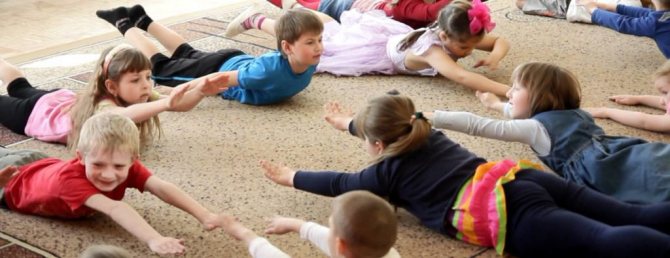
Gymnastics for middle group students should include a larger number of exercises. It is aimed not only at the emotional unity of children, but also at the comprehensive improvement of the child’s body. Elements of breathing exercises are required. It is advisable to combine gaming techniques with a set of exercises to prevent visual impairment and posture.
Set of exercises “Flowers”
Gymnastics after sleep in the senior group
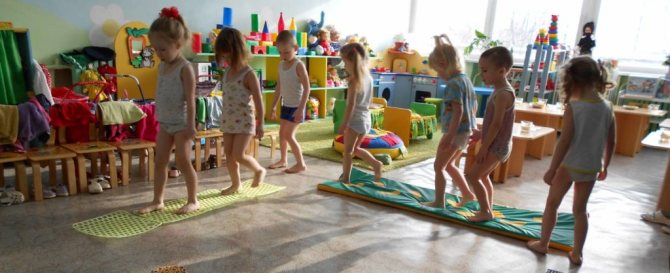
In the older group, the time for gymnastics can be increased. It is recommended to include exercises with exercise equipment and/or sports equipment in the set of exercises. Five-year-old children want to get some exercise and stretch their legs. By this time, daytime sleep becomes a boring and unnecessary procedure for many of them; the guys literally force themselves to lie in bed for the prescribed amount of time. So the more movements offered at gymnastics, the more delight it will cause. You can experiment and offer children games with a skipping rope, ribbons, skittles, hoop, and elastic band.
Set of exercises “We went to the zoo”
Gymnastics after sleep in the preparatory group
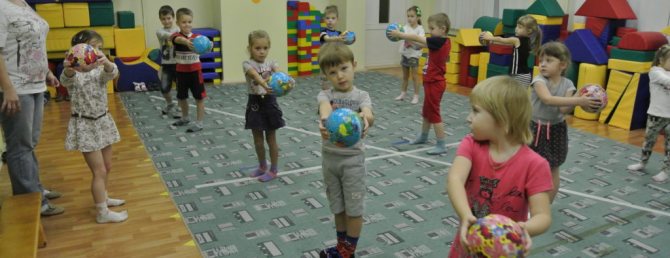
Gymnastics after sleep in the preparatory group should be especially varied and thoughtful. Before us are almost adults, formed personalities. It’s not so easy to get them excited about creating a theatrical performance, but gaming complexes designed for team interaction are suitable. As a rule, the preparatory group is already a real team in which children are accustomed to each other, are ready to exchange experiences, and help each other. Gymnastic exercises can be combined with “mental exercises”, games for intelligence, reaction speed, and concentration of attention of future schoolchildren.
Set of exercises “Sports alphabet”
This is how fun, friendly and enthusiastic, taking into account age characteristics, you can conduct gymnastics classes after sleep in kindergarten. Imagine with your children - and you will succeed!
